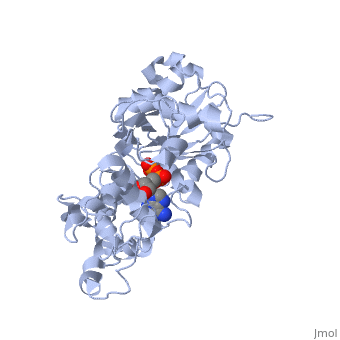2zwh
From Proteopedia
Model for the F-actin structure
Structural highlights
FunctionACTS_RABIT Actins are highly conserved proteins that are involved in various types of cell motility and are ubiquitously expressed in all eukaryotic cells. Publication Abstract from PubMedActin plays crucial parts in cell motility through a dynamic process driven by polymerization and depolymerization, that is, the globular (G) to fibrous (F) actin transition. Although our knowledge about the actin-based cellular functions and the molecules that regulate the G- to F-actin transition is growing, the structural aspects of the transition remain enigmatic. We created a model of F-actin using X-ray fibre diffraction intensities obtained from well oriented sols of rabbit skeletal muscle F-actin to 3.3 A in the radial direction and 5.6 A along the equator. Here we show that the G- to F-actin conformational transition is a simple relative rotation of the two major domains by about 20 degrees. As a result of the domain rotation, the actin molecule in the filament is flat. The flat form is essential for the formation of stable, helical F-actin. Our F-actin structure model provides the basis for understanding actin polymerization as well as its molecular interactions with actin-binding proteins. The nature of the globular- to fibrous-actin transition.,Oda T, Iwasa M, Aihara T, Maeda Y, Narita A Nature. 2009 Jan 22;457(7228):441-5. PMID:19158791[1] From MEDLINE®/PubMed®, a database of the U.S. National Library of Medicine. See AlsoReferences
| ||||||||||||||||||||

